Stone County Quilt Trail
Stone County is located in north central Arkansas in the Ozark Mountains. The county seat is Mountain View, “The Folk Music Capital of the World.” Please take a leisurely drive through our beautiful countryside and into Mountain View to see each quilt block in person. You’ll always find good food and music, people having fun, plenty of places to stay, and a hopping court square reminiscent of days gone by. Quilts and quilting have been a part of the culture here since the first settlers arrived. Every quilt has a story, bits of people’s lives, pieced and stitched into it. Likewise, each of our quilt blocks tells a story about the people and places that make Stone County special. Enjoy the stories shared here about each block. We welcome your comments at the bottom of the page!

6957 Luber Rd.
Mountain View AR
#1-01 – Bear Tracks is located at the Don & Carol Adams residence at 6957 Luber Road, Mountain View, Arkansas. Park in the yard and go through the gate to see the two blocks on the barn. The other two blocks are on the house. Bear Tracks is the first of four blocks painted by owners Don & Carol Adams. The Adamses had two quilt blocks hanging on this barn before the notion of a Stone County Quilt Trail was conceived, so theirs has the distinction of being first. Carol Adams shares the story of her quilt blocks: Quilts, for my family, have always been very special. They were essential to warmth in the winter and they brought us, our family and friends, together as in a social community. On Sunday afternoons, after a large country meal, at my Grandmother’s, we would unroll the quilt and frame from the bedroom ceiling. Our storage place, that for daily routines was out of the way, yet handy to unroll as the group gathered. Our group included three or four generations. There was always much discussion of family news and family histories to learn of. I remember, as a child, sitting beneath the quilt, threading needles for the quilters. I felt like I was in a cozy cave with all my special family surrounding me. The chatter of the conversations above me was very comforting. Now, I enjoy painting and showing my Barn Quilts. There are four on our property. Two are mounted on our old barn. The one pictured above is eight foot square and is called Bear Tracks. This design is over one hundred years old.
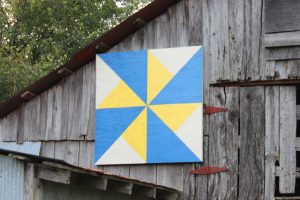
6957 Luber Rd.
Mountain Vew AR
#1-02, Pinwheel, is also at 6957 Luber Rd., Mountain View AR. This pattern was chosen because of the continual wind that blows on our mountain. Our quilts were always very traditional in pattern and fabrics used. We loved a quilt that had pieces of fabrics used in making our dresses. Looking for these special fabrics was truly a treasure hunt for us. Many memories came back from each fabric as it was discovered. One might say that our quilts were very utilitarian, and they were, but when snuggled under one or two of them on a very cold snowy night, they were beautiful, warm and cozy. All we could think of was the fuzzy warm memories of the love that was stitched into them. Blocks #1-01 and #1-02 have been up for more than a decade while blocks #1-03 and #1-04 were more recent additions when the Stone County Quilt Trail was developed.
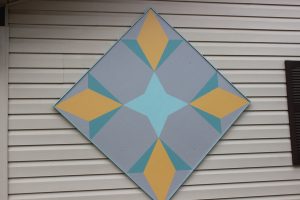
6957 Luber Rd.
Mountain View AR
#1-03, Turkey Tracks is on the Adamses house at 6957 Luber Rd., Mountain View. They chose the pattern as it reminds them of the turkey calls they hear behind their house. Carol Adams shares, “I still quilt today, but with my modern sewing machine. Some are art quilts that are very colorful and beautiful with many, many, many fancy stitches. I love to see them mounted on walls to decorate our homes or on display at county and state fairs. When I think about it, none of them will ever be loved as much as one we can actually sleep under that was handmade with the many stitches of a needle threaded by the younger members and handed off to the generations of stitchers around the quilt.” We appreciate Carol sharing her family memories of quilting and the feelings she still has today when seeing those beloved quilts!
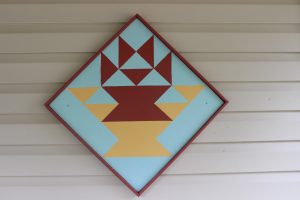
6957 Luber Rd.
Mountain View AR
#1-04, Basket in a Basket, concludes the four blocks found at Don and Carol Adams’ home at 6957 Luber Road, Mountain View AR. It is a well known pattern that Carol likes. It was added to their collection in 2016. Once the Stone County Quilt Trail began in 2016 with a small brochure to direct visitors, Carol was asked if she had seen many visitors to her blocks. She replied with a grin, “the first car I saw that came looking at our quilt blocks had California plates.” We chuckled over that and hoped the quilt trail would bring visitors from near and far. Our thanks go to Don and Carol Adams for being pioneers in the Arkansas Quilt Trails development. Their many years of traveling the country and looking at barn quilts inspired them to have their own. Now they are inspiration for others to paint the brightly colored blocks and preserve the history of quilting.
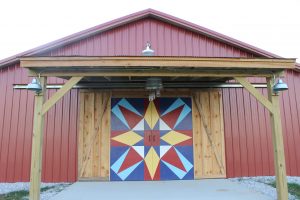
12585 Highway 9
Mountain View AR
#1-05 Front Porch Memories at 12585 Highway 9, Mountain View, AR is five miles south of the court square at Mountain View. The name was chosen to honor the Ozarks tradition of visiting with family and neighbors on the front porch. Many tales have been spun, family lore shared, and homemade pie enjoyed on front porches. The barn quilt was constructed and painted by Glenda Osten with later color modifications made when the barn was painted red. Jennifer King and family, from Cleveland County, bought this large farm in 2015 to satisfy her dad’s yearning for his own place in the mountains. As kids, Jennifer and her sister, Tammie, spent several road trips a year in the Ozarks. Her dad, James Via, has bought and sold real estate as well as been a contractor, building homes and apartment buildings since the 1960’s. The farm now has new owners but the barn quilt remains. Now for a little history about Sugar Hill…How did Sugar Hill get its name? Native Burlean Blackwell related a story she had been told that a Mr. & Mrs. Young who lived up Sugar Hill had seven daughters. When the girls reached dating age, the guys from Mountain View began dating them, and the young men dubbed the place “Sugar Hill.” There’s also a landmark up the gravel Sugar Hill Road. About one mile on the right is a rock bench. It has a sign that says “Sugar Hill Historical Resting Rock.” In the days before automobiles, residents from Sugar Hill walked to the general store out near the old Richwoods School House on Highway 9. It was a hard climb on the return, toting their provisions up the hill, and they needed a place to stop and rest. Sugar Hill is part of the West Richwoods community which was among the earliest settled, long before Stone County was formed.

101 E. Main St.
Mountain View AR
#1-06 Music Warms the Heart, is at 101 E. Main St., Mountain View AR. The quilt block is owned by Hannah Dyke and was originally painted on wood by Glenda Osten in 2014. In 2024 the block was redone on aluminum and painted by Philip and Renee Carr. Hannah chose this pattern as a tribute to early settlers. She shares: “The early settlers arriving in this area met many challenges. The one thing they had in common was the sound of music. Neighbors gathered in homes, barns, and outside for entertainment — singing and dancing their troubles away. This block is a tribute to their lives and determination to develop a better place for their families.” Indeed, folk music is the biggest draw for visitors to the area and is an endearing and enduring heritage that is being preserved. We appreciate Hannah’s tribute to our local music makers, both past and present!
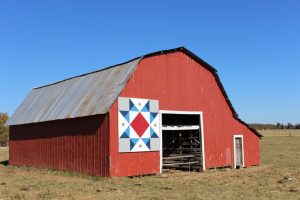
624 Highway 9
Fox AR
#1-07 and #1-08, The Union and Confederate Star barn quilts hang on the barn of Philip and Renee Carr at 624 Highway 9, Fox, Arkansas, in the Rushing Community near the Stone/Van Buren County line. The confederate star is temporarily down and being replaced soon. Parking available on opposite side of highway. The barn was inherited from Renee’s parents, Rodney and Angalee Rushing. The two quilt blocks each feature a different star. The north-facing quilt square is the Union star, painted by Glenda Osten and the south-facing quilt square, painted by Philip Carr, is the Confederate star. The quilt blocks are a tribute to Rodney’s paternal great-grandparents who moved to Rushing in the early 1870’s. The Confederate Star is in memory of John Weaver Hinkle and his wife, Lucy Kenner Hinkle, who moved from Alabama and built the log cabin which still stands today, across the highway to the south and across the county line. Their eighth child, Dan, was born in the cabin in 1876. John Hinkle was a confederate soldier and fought in numerous battles including Murfreesboro and Chickamauga.

624 Highway 9
Fox AR
#1-08, Union Star, on the north side of the barn at 624 Highway 9 Fox AR is the Union Star. The blcok is in honor of Ephraim Owen Rushing and his wife Basha Elizabeth Holland Rushing. The Rushings were part of a of six-family wagon train that moved to Fox Mountain from southern Illinois in 1872. The other families were Harper, May, Branscum, Broyles, and Holland. Ephraim O. Rushing was a Union soldier and fought in the Siege of Vicksburg. Once the Rushing and Hinkle families moved to Arkansas, they lived just one mile apart. A Hinkle daughter and a Rushing son, Phillip Malanthy Rushing and Nioma Hinkle, married in 1888 and are Rodney’s grandparents. Rodney’s parents told him that the two families did not talk about the Civil War. Likely it was such a sensitive subject with the men fighting for opposing sides that they believed it best to move on and leave it in the past. The barn on which these quilt squares hang was built in the late 1940’s by Clarence and Winnie (Rushing) Hinesley with their young sons Carson and Wendell. Rodney and Wendell Hinesley narrated a story about their Hinkle great-grandparents that is found on YouTube.com/FoxArkansas or by searching “John & Lucy Hinkle Homestead.”
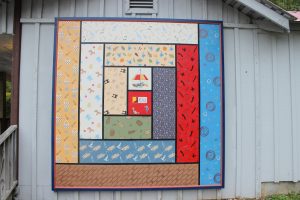
1032 Park Avenue
Mountain View AR
#1-09 Log Cabin quilt block. Located at 1032 Park Avenue, Mountain View, Arkansas at the Ozark Folk Center State Park. It’s on the General Store building in the large parking lot of the park. This barn quilt depicts a log cabin quilt block, a quilt pattern that became popular after the American Civil War as sewing machines became common. This block is simple to piece, preserves fabric from old clothing, creates a practical item, and provides unlimited design possibilities. In the Ozarks, the log cabin quilt blocks often featured a red square in the center, representing the heart and hearth. The heart square in the center of this barn quilt block holds the logo of the Ozark Folk Center State Park, and the young people of past and future. The fabric of each piece of the log cabin block was painted by a dedicated group of volunteer artisans. The design grew organically from the basic pattern of the log cabin block to show every aspect of the park. Look carefully and see crafts, music, herbs, gardens, instruments, artistry and elegance, painted by hand, in a complete picture of a log cabin barn quilt block. The Ozark Folk Center State Park is like the log cabin block, a simple place of buildings created to showcase the heritage of the Ozark people. Like the log cabin quilt block, this park has taken that design and grown into a community that allows creativity in craftsmanship and music to flourish. Many hands worked to make this block, including Troy Odom, printer; Dona Sawyer, glass artisan; Tom Wier, knife maker; Rachel Mathews, copper flame painter; Jennifer Whitman, fiber artist; Bob Nichols, carpenter; Linda Odom, apothecarist; Melody Conatser, basket weaver; Summer Woodsong, wood carver; Robin Woodsong, wood carver; Judi Munn, potter; Dick Augustine, engineer; Danny Shepherd, jack of all trades; Donna Nichols, design artist; Sandy Gonzales, artist; Ray Stafford, teamster; Janice Clark, leather worker; Jeanette Larson, shepherd; and John Morrow, Superintendent, Ozark Folk Center State Park. The mission of the Ozark Folk Center State Park is to perpetuate, present and promote the Ozark way of life in an educational and enjoyable manner through craft demonstrations, musical programs, the Heritage Herb Garden, workshops, and other special events.

1056 South Riverview Lane
Mountain View AR
#1-10 McEntire Family Block, at 1056 South Riverview Lane, Mountain View, is located in a neighborhood near the Sylamore bridge. It’s actually in Izard County, but due to close proximity became part of the Stone County Quilt Trail. Now that Izard County also has a trail, you’ll find it listed there as well. It was painted by Jay and Margaret McEntire and placed on their home which sits next to the beautiful White River. Easy paved entry and exit from the residence to view it. The two flags represent this family’s U. S. Patriotism and is a tribute through our SAR and DAR memberships and to our family ancestors that served as patriot soldiers in the American Revolution.The trees and paw prints symbolize our commitment to preserving natural places and to protecting the environment. This also includes restoring historic buildings and planting trees and native grasses, on over 400 acres…and counting! (Side note: Jay is the only person in the world that has been given permission by the Brazilian government to pull logs out of the Amazon River and it’s tributaries. We did this for many years. He was a board member of the Rainforest Preservation Association that, to date, has saved over 8 million acres of land. This group was led by Don Davis, a Brazilian missionary for most of his life.)

1104 Sylamore Rd.
Mountain View AR
#1-11 Arkansas Crossroads. The Arkansas Crossroads Block was first printed in the Kansas City Star in 1941. Former owner Betty Woods shares: I chose this block for the Dulcimer Shoppe because of our location in Mountain View. You turn north at the crossroads of Highways 5, 9 & 14 to find us. The Dulcimer Shoppe was founded by Lynn & Mary McSpadden along with Lynn’s brother Larry in 1962. At that time they were living in Forrest City, Arkansas. They moved the production to Mountain View in 1972 and built a larger building in 1975 which is the current location. We have manufactured over 63,500 mountain dulcimers and have approximately 120 dealers in the United States and overseas. Jim & Betty Woods purchased the Dulcimer Shoppe in January 2001 after moving to Arkansas from Texas. They retired in 2020 and the current owner, Tim Grothen, is keeping the dulcimer tradition alive. Mountain View is home to the Ozark Folk Center, Folk Festival in April, Bean Festival and Outhouse Races in October as well as wonderful music shows year around. There is always music on the square.

2829 Highway 87
Mountain View AR
#1-12 Swirling Leaves at 2829 Highway 87, Mountain View, Arkansas is on the residence of Donna & Bob Nichols. Located 4 miles from Mountain View’s City Hall. The residence has a nice semi-circle drive for easy entry and exit from Highway 87. Donna’s mother, Karen Walk, painted this block as a Christmas gift a few years back. Karen is a former Stone County resident who now lives in Wichita County, Kansas. Donna estimates that her mother has painted about 150 barn quilts over the years. She’s obviously a key contributor to that county’s claim to fame as the Barn Quilt Capital of Kansas. The Swirling Leaves quilt block has special meaning to Donna since it is a reminder of her mom’s creativity and work ethic. Karen selected the pattern for Donna because of the beautiful hardwood trees in Stone County.

6271 Highway 9
Mountain View AR
#1-13, Bread Basket, TEMPORARILY UNAVAILABLE at 6271 Highway 9, Mountain View AR is found in the Turkey Creek community, about 12 miles south of Mountain View. A few years ago, the Kennon family purchased the farm from Viola Schlabach who had lived and worked there with her husband, Earl, for 40 years. They raised their 4 children in the rock and cedar shake home they built together as a family. The Kennons are honored to be able to continue the small farm tradition by raising livestock on the farm again. The four baskets symbolize the two families’ four children. Austin Kennon is the Agriculture Science teacher at Mountain View School and Amber works on the farm and home-schools their four children. Both are passionate about teaching and encouraging young people. They enjoy working with the FFA and 4-H kids in the community. The Kennon children are active members of Stone County 4-H and enjoy raising, training and showing livestock, as well as gardening and community service projects with their 4-H Club. When looking for a pattern for their block, Amber came across the bread basket and knew that this was “the one.” Mrs. Viola was always gifting her delicious, made from scratch, cinnamon rolls and bread. She and Earl were well known in the community for their kindness and service to others. Amber said, “I was so blessed to have childhood memories of them both, and to again get acquainted with Mrs. Viola and her family during the process of buying the farm. Mrs. Viola has moved to Virginia to be closer to many of her children, grandchildren and great grandchildren but I wanted our block to honor her and the time that she and her family spent in this community.”

206 School Ave.
Mountain View, AR
#1-14, Crazy Quilt, is at 206 School Ave., Mountain View, AR. The Crazy Quilt pattern reached the peak of its popularity from 1890-1910. Local artist Kay Thomas designed this pattern to be representative of crazy quilts of the area, some of which are on display inside the building in the Stone County Museum. The technique involves using scraps to piece blocks, then embellishing to show off embroidery skills. It was a way to turn leftovers into masterpieces. Crazy quilts often made use of woolens and silks and were tacked, without batting, instead of quilted. Kay is an avid quilter and designed the quilt display at the Stone County Museum as well as a pictorial quilt calendar featuring quilts in the museum and around Stone County. The process of making the quilt block starting with Kay sketching and coloring it on paper, then transferring the line drawing to the board which was set up on saw horses in the auditorium of the building. Kay taped off the sections and we had a painting party with Young Single Adults from the Searcy Stake of The Church of Jesus Christ of Latter-day Saints painting the large sections. Kay came back, adding a few artistic embellishments at a time over a several day period until arriving at the final creation. The 6’x6′ quilt block was installed by Philip Carr and John Thomas on May 2, 2017. Inside, the Stone County Museum has a collection of about 12 quilts on display. One of the crazy quilts was donated by Edwin Luther. It belonged to his grandmother, Dessie Jones, who married Dr. J.E. Luther. Family tradition says it was a wedding gift from the Wolf family of Norfork. The museum houses Stone County artifacts dating from the late 1800’s to 1940’s. The Freda & Loy Massey Research Room contains many family histories in binders as well as other local research materials. The museum and research room are open to the public at no charge from mid-April to mid-October on Thursday, Friday, and Saturday from 1:00pm-4:00pm. The Edwin Luther Auditorium is available for rentals and hosts the quarterly Stone County Historical Society meetings and other programs. The Historical Society publishes Heritage of Stone twice a year which is provided at no additional charge to members from their $20 annual dues. Copies may be purchased by the public at the museum or at the Stone County Leader on the court square. To become a member of the society, mail dues to PO Box 210, Mountain View, AR 72560.

162 N. Peabody Ave.
Mountain View, AR
#1-15, Country Patriotic Flag, at 162 N. Peabody Ave is inside the courthouse grounds. It was chosen to honor the many men and women of Stone County who have served in the U.S. military. Names of those who gave the ultimate sacrifice of their life are inscribed on the memorial in front of the courthouse facing Main Street. The quilt block hangs on the stone building housing the Stone County Veterans Affairs Office. Men and women from the Stone County Honor Guard spend many hours volunteering their time at funerals, parades, and programs throughout the year. The Stone County Veterans Affairs Office is open on Tuesday and Wednesday from 8am to 4:30pm and on Thursdays from 8am to noon. Malcolm Sumrall is the Veterans Services Officer and welcomes veterans to contact him at 870-269-4277. The building on which this quilt block hangs was formerly the county jail. Interior walls have inscriptions from former prisoners who wished they were elsewhere. This quilt block had many hands working on it. Philip Carr sketched the pattern onto the board. Young Single Adults from the Searcy Stake of The Church of Jesus Christ of Latter-day Saints painted it on Saturday, April 22, 2017. John Thomas added the border a few days later. The block was installed by Philip Carr on May 2, 2017.
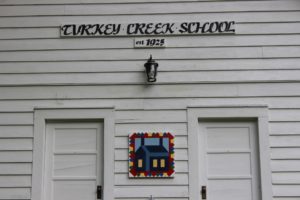
5002 Hwy 9
Mountain View AR
#1-16, Schoolhouse, is at 5002 Highway 9, Mountain View AR. It’s about 13 miles south of Mountain View. The Schoolhouse pattern was chosen to honor the history of this one-room school that was built in 1925 and educated many students over its 22-year existence as a school. It was later used as a church, community center, and polling site. Today it is only used for special programs and an occasional wedding. The Schoolhouse block was the sixteenth block added to the Stone County Trail, a case of serendipity. The number 16 has historical significance to public schools in our nation’s early days when the sixteenth section of land was reserved for public schools. The Turkey Creek School is owned by the nonprofit organization Rural Educational Heritage Inc. In 2016, volunteers from the organization put a new roof on the building which had served it for 92 years. They also scraped off old paint, and added a fresh coat of white stain to the exterior. It sparkles again and, hopefully, is good for another 90 years! Mrs. Elsie Compton was one of the teachers at Turkey Creek. At age 101, she and some of her former students were filmed at the Turkey Creek School, talking about their school day memories. Watch the video on the FoxArkansas Youtube channel at https://youtu.be/mI9y3WqOyOk. Mrs. Compton provided another interview at age 100 in which she talked about teaching in one-room schools. https://youtu.be/ful0-Ub2fhM. A youth band performed folk music on the steps at an event in 2013. https://youtu.be/AU55-dgbV0A.In 1924 Altha Hinesley (Green) taught a summer term in the George Green house and was supposed to finish the school year after harvest in the new building. However the building was not completed until the first of the year in 1925. As a result the first classes in the new building were begun in the winter time with a little “sheet iron” stove in which they burned tie “juggles” for wood. Water was carried from a spring. A well was dug later. Grades one through eight were taught. This was typical of the one-room schools. Mrs. Green reported that she had some nice big charts for teaching the “ABC Class.” The blackboard that is in the building now was that one that was originally used. Ruby Morris Berry told of Mr. Robert Hawkins building desks and seats for the school out under the shade trees while school was in progress. Coleman Morris also remembered that George Green and Robert Hawkins were hired to build the school house. Jeff Morris cut wood for the fire and would deliver it on Fridays so he could hear his children’s recitations. Boys sat on the left side of the one-room school and used the door on the left side of the building. The boys’ outhouse was in the edge of the woods on the left side. Girls sat on the right side of the building and used the door on the right side of the building. Their outhouse was located on the right side of the grounds. As a student left the school room for the outhouse, they laid their book in the door way so other students would know to wait their turn. Some of the directors of the Turkey Creek School were: Sam Duncan, Luther Green, Harrison Berry, Jeff Morris, Logan Berry, Malone Morris, Coleman Morris, and Leland Branscum. After World War II, bus transportation became available in the area and Rural Special School with grades 1-12 was built to accommodate students from a wider area. In 1947 the Turkey Creek School consolidated into Rural Special School, located about four miles away. The Schoolhouse Quilt Block was sketched by Philip Carr and painted by Young Single Adults from the Searcy Arkansas Stake of The Church of Jesus Christ of Latter-day Saints.
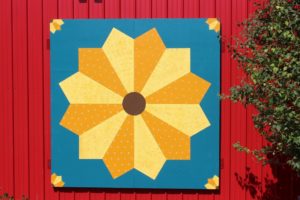
106 E. Washington
Mountain View, AR
#1-17, Dresden Plate is located at 106 E. Washington on The Meeting Place building at the parking lot of the Wildflower Bed & Breakfast, NE corner of Court Square in Mountain View. The dresden plate pattern was introduced in the 1920’s and quilts of this design provided a splash of color during the Great Depression in the 1930’s. The pattern is alternately known as Friendship Ring, Aster, Dahlia, and Sunflower. Chris and Shelley Smith are the owners of the Wildflower Bed & Breakfast, a 100-year old structure originally known as The Commercial Hotel. The Smiths built the Meeting Place at Mountain View on the back lot of the B&B to provide a place for friends to gather for showers, parties, contra dances, musicals, etc. An old-fashioned quilting bee would also work nicely in the spot. The Smiths are transplants to Mountain View and are wholeheartedly contributing to the preservation of folk music, beautiful spaces and their historic building. The Dresden Plate quilt block was constructed and painted by Barn Quilt Artist Glenda Osten co-creator of the Stone County Quilt Trail.

219 S. Peabody St.
Mountain View AR
#1-18, Ozark Country Inn block is at 219 S. Peabody St in Mountain View, within sight of the historic courtsquare. This original quilt block design is named for the historic home it adorns which now serves as a Bed & Breakfast called Ozark Country Inn. It is a tribute to the long history of families who have lived and loved God and country. The builder and owner of this 1906 home, Hamilton S Mabry Sr., also owned a stave mill (sawmill) in Mountain View. He helped to form the Farmer’s Bank around 1914 and served as President and Winfred Rosa as cashier. Later the bank was changed to the Bank of Mountain View. He and his wife Hallie had six children. It has been said that in all of the county Mabry had the most kin serving in the military, 14 in all. One of his sons, Tom died in WWII. Hamilton S Mabry Sr. also served as county judge from 1927-1928. His son Hamilton S Mabry Jr. was a Navy Seabee and was wounded in Okinawa in WWII. He managed a sawmill and became V.P. of the bank. He married Myrtle and they had a daughter Betty Anne. Nathaniel Coleman Maxey and his wife, Seddie Franks, had 2 daughters, Faye Nellie and Maye Lola, and lived in the home. He was a family practice doctor and delivered many of the children in Stone County. One lady who lives in Mountain View said her daddy paid Dr. Maxey a chicken for delivering her. Dr. Maxey came from a long line of physicians, he being the 4th generation. He is buried in Flatwoods Cemetery and his family still lives in Stone County. Former owners, Leonard and Debbie Jadrich, created the block as well as a motto for the inn: “making friends and memories”. Past and present owners have been leaders and servants in the community, attended church, believers in God, served our country and continue the hospitality to all who come to the Ozark Country Inn. The Inn is now owned by Chris and Krissa Smith and he continues the tradition that visitors will have a B & B experience even better than their own home.
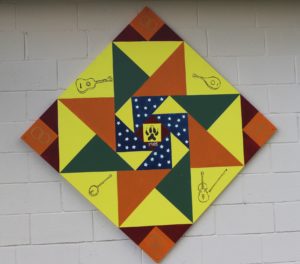
16262 AR-263
Fox AR
#1-19, the Unfolding Star, hangs on the Fox Community Center at 16262 AR-263, Fox, AR 72051. Painted by Philip Carr with embellishments chosen by Renee Carr, it’s a tribute to Fox musicians, local veterans, and long marriages. It’s sponsored by Rural Educational Heritage Inc. The center of the block features a fox paw print to recognize the name of the town, established officially in 1905 when the post office became known as Fox. This also became the name of the unincorporated community. The golden wedding bands at each corner represent the “Golden Wedding Wall” inside the community center that has over 100 photos of couples who’ve reached the 50-year anniversary milestone. The white stars on blue background represent the 240 veterans from the Fox area who are pictured and surround three walls of the community center, honoring the contributions of our U.S. veterans. The musical instruments painted on the block: guitar, mandolin, banjo, and fiddle are a tribute to the homegrown folk musical talent which has come from this mountain community over the last century and has influenced many beyond Fox Mountain. The Scotch-Irish influence from the early settlers who came from the southern U.S. is found in the Ozark Mountain folk music. Floyd Holland, born 1891, was a self-taught banjo picker. He lived to be 95 and was an early banjo player and singer at the Ozark Folk Center and performed at the first Arkansas Folk Festival in 1963 at the music event in the high school gym. Today the banjo tradition is kept alive on Fox Mountain by the talented Darrell Barnett. Though his roots are in Shirley, he had the good fortune to marry Carla Kocher Barnett, a great-granddaughter of Fate Morrison who also made his musical mark on the community. Brothers David Jackson Lafayette “Fate” Morrison (b. 1905) and William “Willie” Morrison (b. 1907) descended from early settlers in the Meadowcreek valley and Fox. The fiddle playing brothers helped preserve the folk music heritage of Stone County. At this link you can listen to their old-time fiddling with guitarist Seth Mize playing Wednesday Night Waltz. https://www.slippery-hill.com/recording/wednesday-night-waltz-0 Throughout the 1960’s and early 1970’s, the three joined with Timbo neighbor Jimmy Driftwood playing for audiences all across the country, bringing an awareness of folk music and Stone County that would help pave the way for the Ozark Folk Center to launch in 1973. A folk music band from Fox performed at the 1972 inauguration of Richard M. Nixon. Willie and Fate Morrison played fiddle, Otis Johnson played guitar, Harlie Dampf played banjo and Willie’s son, Glenn, played mandolin. Glenn chuckles at the memory of this group of mostly Democrats playing at the inauguration of a Republican president. It was customary over the years for Fox community members to socialize by attending “Play Parties.” A couple would host the gathering at their home, and visitors came with their musical instruments. The jam session would last for hours. Lonnie Lee (b. 1926) and his wife, Neda (b. 1928) made their home in Lonnie’s native Fox after their marriage in 1945. He was a logger and sawyer. Local performer Dave Smith credits the Lee’s hospitality with their Saturday night musicals for providing the setting where he could learn to play the old-time folk instruments and learn songs when he moved here as a 20-year old in the 1970’s from northern Illinois. Lonnie played the guitar and was happy to teach others. Dave Smith was an attentive student and became a talented musician, playing guitar, fiddle, mandolin, banjo, and accordion. He is a guest performer and sometimes Master of Ceremonies at the Ozark Folk Center. Over thirty years ago Dave and his friends, Robert & Mary Gillihan, formed a band called Harmony that is still performing. True to their name, their vocals are harmoniously beautiful. Perhaps Dave’s most important contribution is sustaining the Ozark Mountains folk music by teaching Rural Special School students to play folk instruments through the Music Roots program. Dave is also the host of the weekly Ozark Highlands Radio show which broadcasts folk music programs throughout the world. Listen to an August 2018 interview of Dave Smith http://www.hppr.org/post/interview-dave-smith-ozark-highlands-radio. Jeff Glover of Fox is the producer of the Ozark Highlands radio show. He has his own musical talents, playing a muted trumpet and performing on occasion with his children Fox and Rori. They play favorites from the 1920’s-1950’s era, and their tight harmonies really take you back in time for an enjoyable experience. There are also bagpipers on Fox Mountain. Glenn Morrison, son of the aforementioned Willie Morrison and Laura Cummings Morrison, learned how to play bagpipes after his retirement from teaching school. Another bagpiper, Cindy Chiodini, moved to Fox Mountain in 2000 and learned to play the bagpipes. She is a volunteer with the Stone County Honor Guard and performs at countless parades, events, and for funerals of veterans. The Fox Mountain Bluegrass Band played and sang for almost two decades with members including brothers Bill and Corbet Bonds, Scott Branscum, Benny & Kathy Morrison Kocher, their daughter Carla Kocher Barnett with Carla’s banjo playing husband, Darrell Barnett. Occasionally they are joined by singer Bethany Barnett. Otis & Patsy Stevens of Alco were with the group in the early days. Finally, gospel music has had a strong presence and influence around the Fox community. From the 1930’s through 1970’s many residents, both youth and adults, attended singing schools and learned to recognize and sing shaped notes. With nine churches on the mountain, a wide-variety of songs and music can be enjoyed today from acapella style to quartets, choirs, soloists, bands, piano, and even one saxophone-playing pastor. You might hear I’ll Fly Away or Just a Little Talk with Jesus mixed in with some more contemporary gospel songs at Sunday morning worship service.

116 Howard Ave.
Mountain View AR
#1-20, Sunbonnet Sue hangs on Aunt Minnie’s Yellow House, at the NW corner of the Stone County Court Square, 116 Howard Avenue in Mountain View. It is a 4’x4′, painted by Glenda Osten. Proprietor Jana Wickham, owns and operates Aunt Minnie’s Yellow House but it is a three generation undertaking with her son and her mom, Pat Cash, a.k.a Aunt Minnie playing key roles. Jana’s family on both her mom’s and dad’s side have very deep roots in the town of Mountain View and Jana enjoys keeping tabs on all that through genealogical research and recording family history. Aunt Minnie’s Yellow House has become an iconic fixture anchoring the northwest corner of the square. It’s yard is a haven for pickers and grinners and this Sunbonnet Sue is ready to jam with her fiddle. There is a lot to write about Sue – she’s been around for quite some time. Quilt blocks of Miss Sunbonnet began showing up as early as the 1800s, but popularity with crafters only began to grow after the publication of the Sunbonnet Babies Primers in the early 20th century. Bertha Corbelt and Eulalie Osgood Grover (what a name!) teamed up to teach children how to read through illustrated anecdotes about Sunbonnet Sue, Fisherman Fred and Suspender Sam. Teachers, parents and children fell in love with Sunbonnet & Co. due to her sweet temperament, wholesome vignettes of everyday life and that adorable ever-present bonnet. In a nutshell, Sue was the 20th century Elsa. Sunbonnet Sue has definitely had staying power! Aunt Minnie’s Yellow House gift shop is a destination in itself, carrying kitchenware, splatterware, clothing, jewelry, t-shirt screen printing, monogramming, and the list goes on. Take a look at AuntMinniesYellowHouse.net.

13731 Hwy 263
Fox AR
#1-21, The Berry-Morris Star, located at 13731 Highway 263, Fox, AR, was made in honor of the Berry and Morris families. In the early 1900’s two families homesteaded neighboring farms on Turkey Creek in southwest Stone County on what today is called the Coleman Morris Road. Logan and Goldie (McMullin) Berry had twelve children who helped milk and care for their dairy cows and farm. Jeff and Gertie (May) Morris had eleven children who helped in their Dad’s mercantile store as well as gardening and farming. It was inevitable that a romance would develop between some of the neighbor children as they grew up. As Ruby Morris Berry liked to relate, “Aubrey jumped the rock fence between our farms and came calling!” Aubrey and Ruby married in 1938 and soon began their own family that would grow to eleven children. The names of the Berry and Morris couples are painted in the center yellow star of the quilt block as anchors of the family. The names of Logan and Goldie Berry’s children are painted in the twelve outer points of the navy star, starting with the eldest, Olvie (Finch), at center right and going clockwise around the star in birth order with Aubrey (Berry), Oval (Chambers), Albert (Berry), Silas (Berry), Edith (Johnson), Thomas (Berry), Wilma (Holland), Evelyn (Johnson), Lila Belle (Sutterfield), Jimmy (Berry), and Marie (Barnum). The names of Jeff and Gertrude “Gertie” Morris’ children are painted on the inside of the navy star starting with the eldest, Malone (Morris) at center right and going clockwise by birth order with Ola (Finch), Celia (Ivy), Retha (Hastings), Elsie (Compton), Coleman (Morris), Edith (Johnston), Genevieve (Copeland), Ruby (Berry), Cleo (Morris), and Loyce (Ackerman). Aubrey, born 1914, was industrious and found ways to involve his growing family in making a living while Ruby stayed busy caring for the children, cooking, and sewing their clothes. Aubrey began working in the timber for Eppes Mabry of Mountain View and after a few years began buying his own tracts of timber to harvest, moving his family to Roodhouse, Greene County, Illinois for several years while he worked there. He always moved his sawmill to the worksite. Turkey Creek drew them back home where they farmed and Aubrey continued in the timber until another kind of harvest called them to east Arkansas where they began working in the cotton fields around Blytheville. Aubrey and Ruby sharecropped and the girls picked cotton and were fast pickers! Turkey Creek called them back just in time for their eldest daughter, Angalee, to finish school at Rural Special School where all eleven children would attend. By this time Aubrey and Ruby had moved to a house across from the school near Fox. More work opportunities would call them away. They loaded up the family and headed north to Michigan to work in the cherry harvest in 1951. They made a stop at Michigan Blueberry Growers Warehouse where, because of their young children, they were told, “You need to be picking blueberries!” They arrived at the Kiel Blueberry Farm where the owner looked inside the car and seeing the carload of children said, “Lord-a-mercy!“ He hired them on the spot. That started a tradition that lasted 20 summers, from 1951 to 1970 as the Berry family made the trek north to Grand Haven, Michigan each June where Aubrey worked as a field boss for the Kiel’s and continued after the Reenders family bought the blueberry operation. He and Ruby and all eleven children picked blueberries until it was time to return home for school each fall. The kids were especially good pickers and liked to compete with one another on production. The names of Ruby and Aubrey’s children are painted on the inside of the outer diamonds of the quilt block, starting with the eldest Angalee (Rushing) at top right, and going clockwise in birth order: Gearldee (Dodd), Shirley (Sutterfield), Dayle (Bonds), Gayle (Morrison), Janice (Miller), Deloris (Brewer), Faye (Rushing), Jay (Berry), Randy (Berry), Marty (Berry). Their spouses’ names also appear in the diamond along with their children’s name at the outer tip of the diamond. This completes a four-generation chart for the family. The quilt block is an especially fitting tribute since Ruby hand-pieced and quilted many quilts over her lifetime. She made quilts for 32 grandchildren upon their graduation from high school. Spending 20 summers in Michigan would inevitably lead to another romance as the Berry children grew up. That’s what happened when Jay Berry married Judy Reenders and persuaded her to move to his home in Fox, Arkansas. They brought along with them experience in growing blueberries and were among the earliest growers in Stone County. Their four children Brian, Adam, Tonya, and Brittany were all involved in the family operation. The quilt block was designed by Renee Rushing Carr, a granddaughter of Aubrey and Ruby Berry, who is an avid genealogist. The block was painted by her husband, Philip Carr, with names added by Renee. The artistic elements of cotton boll, blueberry cluster, saw, and logging truck in each corner were painted by Scott Miller, a grandson of Aubrey and Ruby, to represent the family’s work ethic. The quilt block is located in the yard of Jay and Judy Berry where antique machines are also on display including an antique road grader that was used to improve the road (now Highway 14) between Mountain View and Batesville in 1924, a Fordson tractor, a two-bottom horse drawn plough, and a horse drawn two-row planter. They ask that visitors pull into the driveway to view the block and to turn around on the grass before leaving since backing out on the highway can be dangerous.

201 W. Main St.
Mountain View AR
#1-22, Pinwheel Star and #1-23, Diamond in the Squares are located at 201 W. Main Street, Mountain View AR. They can be found on the old blacksmithing forge behind the Urban Forge retail store in beautiful downtown Mountain View. The name Stone County Ironworks has been around for decades, but the unique art of blacksmithing has been around for hundreds of years. The pair of quilt blocks on the side of our Old Forge represent the old and new. The darker quilt square represents the history of the unique craft of blacksmithing and the new with brighter colors represent what our craftsman do today. Our blacksmith artisans craft our products using tools and techniques that are over 100 years old. Our oldest tools were made in 1844, but the hammer, the anvil, and fire are still essentials of the trade. As for the new, our artisan blacksmiths are constantly coming up with new techniques for the new modern approaches and designs. After viewing our Old Forge outside, step inside our retail store for a glimpse of modern blacksmithing creations made a couple miles down the road in Mountain View, Arkansas. Hours are 10AM – 6PM Tuesday-Saturday. Learn more at https://urbanforge.com/.

201 W. Main St.
Mountain View AR
Today the Mountain View Iris Festival Committee maintains the lot where quilt blocks #1-22 and #1-23 are located. They brought the decorative fish pond back to life, planted irises and landscaped, and added two beautiful quilt blocks. The 2′ x 2′ blocks were painted by Iris Committee Member Kay Thompson who is a quilter and painter. Committee members planted irises around the historic court square and along city streets for visitors and residents to enjoy in the springtime and during festival. The Mountain View Iris Festival is hosted each year with the next one scheduled for April 30-May 1, 2021. Learn more about Iris activities at https://mountainviewirisfest.com/. The committee accepts donations and memorials to fund the festival and beautification efforts. A photo contest is scheduled in conjunction with the festival. See the website for guidelines for the free contest.

102 E. Main St.
Mountain View AR
#1-24, The Tipi block is at 102 E. Main St., Mountain View AR. It is located on a historic building next to the court square. The pattern is painted onto metal and hangs on the alley side of the building. It’s visible from Main Street, but you can best view it by pulling into the alley way street. Wikipedia tells us the building is listed on the National Historic Register. The Farmers and Merchants Bank is a historic commercial building name for its original occupant. It is a two-story stone structure, with a flat roof obscured by a parapet. Built out of rusticated stone, it has vernacular Romanesque styling in its rounded window and door openings on the first floor, and its crenellations at the top of the parapet. It was built in 1910, during the city’s first major period of stone construction, by Bill Laroe, who also built the Stone County Courthouse. Quilt block owner Virginia Ivy shares the story behind the block selection. From pre-recorded history to today, it is the creeks and rivers that drew people to Stone county and kept us here. These waterways were the first superhighways through the rough Ozark terrain. Our quilt (and others that have been commissioned forthcoming) were created by Steve Mollenkof to reflect our passion for being on the water and to remind us to go with the flow. Along south Sylamore Creek, you can rent an authentic tipi on sublime private property in a ‘holler.’ You had better be a brave driver with a big truck ; it’s an adventure to find this secret spot. Don’t feel like off-road prowling? You can rent the upstairs recently built loft of the historic building that has been described as the “best of SOHO chic blended with the finest southern authenticity.” Ivy Vacations LLC 870.292.6936
#1-25, We are sorry, but this block has moved out of state with its owner.
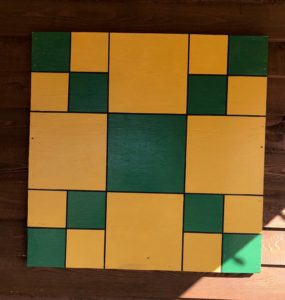
802 E. Main St.
Mountain View AR
#1-26, Stone Quilters is named in honor of Stone County quilters, past and present, who’ve made quilts and kept the quilting tradition alive. It’s located at the Stone Bank pavilion, behind the bank, on Heritage Drive. Local quilters are quilting into their 80’s, 90’s, even 100’s. Elsie Morris Compton of Turkey Creek lived to be 102 and quilted most days during her retirement years, sometimes singing as she quilted. Her sister, Retha Morris Hastings, made quilts that she shipped to almost every state in the country. Another sister, Ruby Morris Berry, made quilts for family members including 32 grandchildren as they graduated high school. Her daughters continue the quilting tradition. Lois Dodson worked as quilter at the Ozark Folk Center into her 90’s. Over her lifetime she had made and sold over 700 quilts! Blanche Richardson was a skilled quilter who also spent years in the quilt shop at Ozark Folk Center. A transplant from the Florida Keys from about 35 years ago, Susan Jewell keeps the tradition alive at the shop today. She enjoys the monthly quilting at Shady Lawn Mennonite Church on Highway 5 South on the first Thursday of the month (pre-pandemic). It was there that Esther Mast helped Susan learn to quilt. Nancy Snyder of St. James is also a talented quilter at the OFC quilt shop. Neva Foll was well known for her quilting as was Ortha Younger of Pleasant Grove. Genevieve Dawson. Lula Hudspeth, Judy Johnson, and Katie Lockhart are names synonymous with quilting. Waneda Bontrager and Edna Mast from the Happy Hollow area are prodigious quilters. Linda Siebert Havner was a quilt shop owner and quilter in Mountain View several years ago and has a shop in Calico Rock at present. Daphne Higginbotham and Renee Riggan quilted and operated quilt shops in more recent years. Carla Smith from the Sunnyland community is a talented quilter, and Jan Hickman adds her artistry to quilting. Betty Woods brought her love of quilting with her from Texas and after retiring from co-owning and operating the Dulcimer Shop, she now has more time to spend quilting. Kay Thomas’s love of quilts and quilting is evidenced by a quilt display she created at the Stone County Museum that includes 12 beautiful antique quilts. She quilts her own creations today. Anna Brewer parlayed her experience at the Blanchard Shirt Factory into a machine quilting business that has been a resource to residents and visitors over the years. The Crazy Quilters group has historically met on the 1st Saturday of the month at the First United Methodist Church in Mountain View, but the group is currently on hiatus due to the pandemic. If there are other Stone County quilters who should be recognized or remembered, please make a comment on this page, so their names can be added. The Stone County Quilters block is painted in the gold and green colors of Stone Bank. It was painted by Philip and Renee Carr and donated in appreciation of the sponsorship of Stone Bank for Arkansas Quilt Trails. Stone Bank hosts the Veteran spotlight program that each month honors a veteran residing in the county. The bank is also a sponsor of the Arkansas Craft School as well as Ozark Highlands Radio which originates from Mountain View at the Ozark Folk Center.
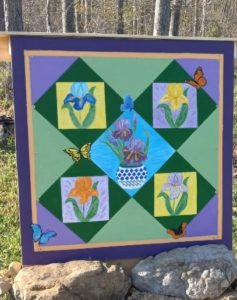
9396 Highway 5
Mountain View AR
#1-27, Iris Crossroads: Memories of Grandmother’s Garden, is an iris-and-butterfly theme quilt square found at 9396 Highway 5, Mountain View. It welcomes Stone County travelers approaching Mountain View’s southern city limit. Look for it on the right, less than a half mile after crossing the Highway 5 Purple Heart Bridge over Raccoon Creek. Quilt block designer/owner Kay Adkins explained, “The inspiration for the iris design came from favorite childhood memories of traditional Easter and Mother’s Day family gatherings at my Grandparent’s home in Dallas, Texas. “My Grandmother’s favorite hobby was tending to her irises and rose bushes, and maintaining her lawn—which she enjoyed doing herself well into her late 80’s.” Simmons’ family Easter celebrations created many special memories. Kay said, “I remember being required to stay dressed up in our Easter best until the whole Simmons ‘clan’ had arrived at Grandma’s. We grandkids were nagged to keep our clothes clean.” Before sitting down to Easter dinner, there were traditions to uphold: First: family pictures in the garden- each family, then each generation with Grandma—her kids, her kids with their spouses, grand kids, great grand-kids, etc. Next: the ‘parade’ through the iris and rose garden pathway; Dolled-up in bonnets, frilly dresses, white gloves, and white patent leather shoes and purses, the aunts and girl cousins strolled the rose and iris garden ‘runway’ to document the parade for the (grainy quality) 8mm home movies we treasured! “We grand-kids thought we would NEVER get to change clothes, fill up on ham, yeast rolls, and devilled eggs. And not just because we were uncomfortable and hungry. Mainly we were anxious to rush back to the flower garden with our Easter baskets for the egg hunt (irises are perfect plants for hiding Easter eggs!).” Iris bulbs from Grandma’s house were divided often, and given to any family members or friends wishing to carry on the iris legacy.
5 Bearded Iris color varieties/names represented in Iris Crossroads:
- Purple iris arrangement in the center: Fiddlin’ Around.
- Blue iris: Amas
- Yellow iris: Pure as Gold
- Orange iris: Orange splash
- Lavender iris: August Treat
5 Butterfly varieties (All native to Arkansas. One is the official Arkansas STATE Butterfly!)
- Top right: Monarch
- Upper center: Spring Azure
- Left Center: Eastern Tiger Swallowtail
- Lower Left: Red spotted Purple
- Lower Right: Dianna Fritillary (Arkansas State butterfly!)
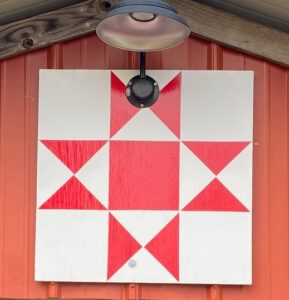
2608 E. Main St.
Mountain View AR
#1-28, Ohio Star, and #1-29 Red White & Blue, are at 2608 E. Main St., Mountain View. Owner Kathy Lupkes shares the story. I remember as a young girl my grandmother helping quilt at church. My sister quilted for years and I treasure the quilted potholders she made me though now tattered and worn. In Iowa was where I first saw barn quilts…amazing beauty adorning the countryside. As we moved to Arkansas I was happy to see all the barn quilts here on all the different buildings. Since we now had a barn I decided it needed a quilt. So I made a simple red, white, and blue for our barn and an Ohio Star for our other little red building. In the future I think I need to do a little one for the chicken house.
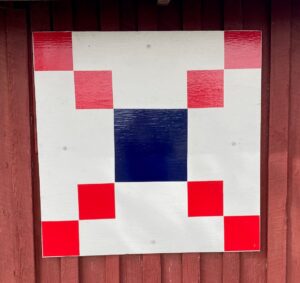
2608 E. Main St.
Mountain View AR
Enjoy a visit in our town of Mountain View as you explore quilt blocks.
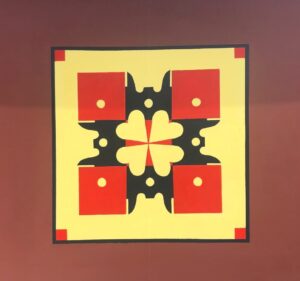
501 Knox Ave.
Mountain View AR
#1-30, Hearts of Steel, is an Arkansas Craft School quilt block located at the Windgate Craft Annex, 501 Knox Avenue, Mountain View, Arkansas. The Hearts of Steel quilt block can be seen prominently displayed on the south side of the Annex, facing Gayler Street. The Windgate Craft Annex, also known as the Forge, houses the creative blacksmithing and blade smithing classes offered by the Arkansas Craft School (ACS). Blacksmithing is an ancient art that has been practiced for thousands of years and has played a vital role in the development of human society throughout history. Blacksmiths, also known as “smiths”, used tools such as anvils, hammers, and tongs to manipulate the metal, as well as heat it in a forge to make it more pliable. The term “blacksmith” comes from the practice of using black coal to heat the blacksmithing forge. Once, the smith used the strength of their arms to fashion essential items of tools and weapons, but now more creative works such as jewelry, artistic embellishments like fixtures on buildings and sculptures, decorative ironwork, as well as the restoration of historical objects is the trade of the smiths. The brightly painted Hearts of Steel quilt pattern in the ACS colors of fire red, carbon black and Laguna yellow was inspired by the Lone Star quilt pattern. The pattern lent itself to the use of the anvil. The hearts in the design represent the love of creating in metal whether it be steel, iron, copper, brass, tin, or aluminum. The creation of the quilt square, Hearts of Steel, was done by ACS board members. The original design and color scheme was created by Jamie Murawski, constructed by Stanley Brown, and artistically painted by Khaki Minick and Lauren Caston. The Arkansas Craft School is a nonprofit 501(c)3 organization whose mission is to promote a vibrant, creative community that inspires a life affirming appreciation of and support of the arts. In addition to the programs taught at the Forge, the ACS encompasses many styles of craft arts, both contemporary and traditional. With two locations in Mountain View, the ACS is dedicated to the growth, appreciation, and instruction of craft arts offering year-round community enrichment workshops in metal clay, fiber, glass, jewelry, wood, photography, studio arts, and young artist programs. Additionally, the ACS offers sixteen weeks of Career Competency Training. Licensed by the Arkansas Department of Higher Education, the ACS is certified to provide programing in Artistic Blacksmithing, Fine Woodworking, Textile/Fiber Arts, Ceramic/Pottery or Jewelry Making. Upon completion of the Career Competency program students are awarded a Certificate of Competency in their specific discipline.
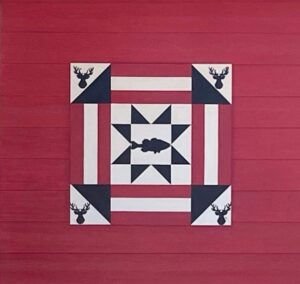
441 Jimmy Creek Rd.
Fox AR
#1-31, Great Ozark Outdoors, at 441 Jimmy Creek Road, Fox, AR is on Todd and Kim Hudspeth’s home. Kim shares the story of heritage and a love of the great outdoors that the quilt block represents. The six horizontal stripes represent the generations that this property has belonged to. The top line belongs to Kim’s great great Grandparents John “Ed” Branscum and his wife Martha Kendall Branscum who owned a store not far from the property, the next white line belongs to her great Grandparents John and Bessie Perry who lived and farmed the property and then saw fit to give the land to their children. The next patch represents Duane and Loretta Perry who were Kim’s grandparents. Skip to the bottom lines the first belongs to Kenny and Debbie Perry (Kim’s parents) who built a farm on the property many years ago. The next white line represents Todd and Kim and them now living on the property. The final red line represents their children who now reside on the property as well. The vertical stripes represent Todd and Kim coming from two different families but melding together to tie it all together. The fish facing forward is a representation to always look ahead and keep moving forward. Todd, Kim and all their children are avid outdoorsmen and really enjoy hunting and fishing the deer and fish are to represent that love. The deer are a representation of their four children. The peaks and valleys around the fish are to represent the landscape of this area, the hills and the valleys that this beautiful area is known for as well as a reminder of the ups and downs of this life.

300 Mountain Crest Rd.
Mountain View AR
#1-32, JJ Forge quilt block is at 300 Mountain Crest Rd., Mountain View, AR. This barn quilt was created with much thought and fun by Joe and Jacqueline Felber with a little help from the grandkids. It is on the rusty red shop of JJ Forge. Inspired by the love of God, family, community and quilts, this piece says much about our work and our life. The anvil is in the center. It has been a symbol of metalsmithing for centuries. When you hear the ping, good things are happening. Either you are working, inspired, teaching, or just playing around. It’s all good! Surrounding the anvil is a sawtooth star, also known as a morning star. The star is silver with copper trim depicting the metals often used for art and function. Native Americans believe the symbol honors and protects the recipient in their travel through life. We hope for those traveling the quilt trail will not only have traveling mercies, but enjoy the beauty of each quilt’s style and representation. The four corners are green or a patina, black representing iron, and silver metalic with copper brands or marks for our four grandchildren: Bryce, Ty, Kaden, and Wade. They actually designed these brands and helped in creating this part of the project. We are grateful to be a small piece of this connecting quilt group in Stone County and the fun and creative time we were able to spend on this project. May all those who gaze upon our barn quilt find some kind of creativity or imagination. “If you hear a voice within you say, ‘you cannot paint’ then by all means paint, and that voice will be silenced.” Vincent Van Gogh

875 S. Bayou Dr.
Mountain View AR
#1-33, Bride’s Bouquet, is at 875 S. Bayou Dr., Mountain View, AR. Olene Gilbert says it was an “accidental meeting” when she first met Hoover Gilbert. Olene was teaching at Timbo School in Stone County. Mr. Poff, the principal, decided to take the young people in the community to see a movie at the Uptown Theater in Mountain View. Mr. Poff had a truck with camper that they rode in. Hoover was in the group and had a date for the movie. Olene was staying with a family in Timbo during her teaching assignment there and they invited her to go to the movie too. Hoover loved to tell the story, “I took one girl into the movie and I brought another girl (Olene) out of the movie.”
Olene went home to Desha for summer break. There were no phones then, so the couple wrote letters to one another. About their courtship, Olene remembered, “It was understood we would get married, he didn’t propose.” They decided by letter that they would get married. Hoover’s mother, Ollie Gilbert, was visiting her sister in Wynne, AR. Hoover wanted to go get his mother and bring her home. In the meantime he got a marriage license. On the way to Wynne, Hoover and Olene decided to get married on the trip. Olene was 20 and Hoover was 21. They picked up his mother and borrowed $5 from her. He got hotel rooms for the three of them for $1 per person. That left him with $2 in his pocket. They searched and found a minister, Reverend Upchurch, at the parsonage of First Baptist Church in Bald Knob. After they were married, Hoover asked the minister what he owed him. The minister said, “what’s she worth?” Hoover said $2.00, that’s all I’ve got!”
They rented a place in Big Flat and Olene taught the next term there. Hoover went back out of town to work for awhile. In that era, schools dismissed school for six weeks in the fall for families to go to “the bottoms” (east Arkansas) to pick cotton. The young couple decided to go to the Little Rock area to find work. Olene’s father was a carpenter and her parents had moved to Sylvan Hills for work. Olene went to work doing office work and worked the switchboard for Faucett Real Estate Company and road the bus to work. Hoover worked for a service station at Little Rock. They had an apartment at Levy. She was expecting their daughter, Susan. The policy was that a worker could not continue working if she was “showing” so Olene had to quit work when about 3-4 months pregnant. Their daughter, Susan, was born in 1951. Hoover would say throughout his life, “Susan is the best thing that happened to us.” When Susan was 16 months old, the family moved to the San Francisco Bay Area. Olene worked at Berkeley Radiation Lab for the Atomic Energy Commission as a secretary and stenographer when they were developing the H-bomb. Hoover worked for Standard Oil refinery and service station. After a year, they returned to Stone County where Olene taught at Big Flat. By summertime Olene persuaded Hoover to go to college. She had a two-year degree and wanted to get her four-year degree. He was 25 and thought he was too old, but she convinced him to do it. Olene got a job teaching at Greenbrier High School, going to college classes on Saturday and summer school to finish her degree. Hoover went straight through fall, spring, and summer terms. He finished in May 1958 and Olene completed her degree in August 1958, both at what is today the University of Central Arkansas.
Hoover did his practice teaching at Sylvan Hills. They were just starting a sports program and offered him the job of basketball coach. Eventually he was also the athletic director. Olene was hired as math teacher at Sylvan Hills. This started a tradition of them always working at the same school which provided them more togetherness and the opportunity to support one another. Coach’s team went to state the first year he coached. Olene was cheerleader sponsor, pep club sponsor, attended all the games, rode the pep bus, sponsored senior play and homecoming, and kept the gate at all home games. She recalls how very helpful the parents were.
By 1967, they were back in Stone County. Olene taught math at Mountain View and Hoover was the director of the new NADC program. In 1968, the Gilberts built a house in Fox on land they had purchased while living in Sylvan Hills. In 1969, they were both teaching and coaching in Timbo. In 1975 Olene became the business teacher and librarian at Rural Special High School, just a mile from their house. A semester later Hoover became the coach of all four basketball teams there. She was always at the games and supportive of all the teams. He built winning teams that worked hard together and wanted to do their best for Coach. Mountain View senior girls had a 24-year streak of winning the Stone County tournament. In coach’s second year at Rural Special, he led the Rebel girls to their first Stone County tournament victory, and they repeated the following year. The boys won the Stone County tournament each of his years at Rural Special. His Rebel senior teams did not lose a game on their home court in the 1978-1979 year, and they lost very few road games. Olene taught business classes which included typing, a skill used every day by most of her former students even to this day. She was again the biggest supporter of the teams in addition to their daughter, Susan, who by then was the Home Economics teacher at Rural Special School.
In their retirement years, Olene and Hoover babysat their granddaughters, Erin and Lauren, until they started school. They went to all their granddaughters’ activities and he coached their peewee teams.
When asked for any advice for couples, Olene replied. “Do a lot of give and take. Do things together.” “Stick together through thick and thin.” After they retired, the couple went fishing together, raised cattle together, and went to the cattle sales together. They went to music shows and danced together at the Folklore Society. They loved the “Pickin’ Park” on the square in Mountain View, the Jimmy Driftwood Barn, and the Senior Center, just any place they could enjoy together.
Though Olene did not have a bride’s bouquet when she got married, the bride’s bouquet quilt pattern has special meaning to her. She says it’s representative of the nonfading 73 years of love she and Hoover shared together. He passed away in 2023 at age 94. He loved flowers as she did. When he saw something in bloom, he would pick one and give it to her. Olene reflected, “You don’t have to have an expensive wedding for it to last.”
The Bride’s Bouquet was painted by Philip and Renee Carr, both former students and ball players of Coach and Mrs. Gilbert.
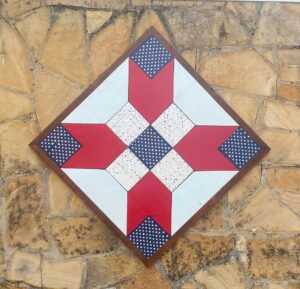
223 W. Main St.
Mountain View AR
#1-34, Farmer’s Daughter, is at 223 W. Main St., Mountain View, AR. You will find the small block facing Main Street between the two entrance doors. A larger 4’x4′ version is found inside the store on the deli wall. If you arrive during business hours, please come in and take a look! Todd and Tina Ramsey of Timbo are the owners of the Farmer’s Daughter Vendor Market. It was only fitting to have the traditional Farmer’s Daughter pattern on their business building. The Farmer’s Daughter has significant meaning to the owners of the vendor’s market, for the farmer that is referred to here is the very first farmer ever (God), and Tina claims to be only one of many of his daughters! Their greatest enjoyment is meeting new folks and sharing their story. Please stop by and view the Farmer’s Daughter quilt block and come on in and find some wonderful antique or vintage treasures as well. You won’t be sorry you did!
Thanks to the quilt block owners and painters in Stone County that have helped us get Arkansas Quilt Trails started. Stone County has a strong connection to quilting. It’s a part of our heritage! Also, a special thank you to Glenda Osten who loves visiting quilt trails and helped get this one started, even painted several of them!
What a great start for barn quilts in Stone County. My husband and I hope everyone, here, will become as proud of the quilts as we are. It is our heritage, both the colorful quilts as well as the folkart presentations mounted on our barns and other out buildings.
Thank You, both Renee and Glenda for all your work on this project.
And thank you, Carol, for leading the way with your beautiful quilt blocks!
beautiful stories and pictures Renee !! I always wondered about the barn quilts (didn’t know they even had a name) as I quilt too and always wished I had a barn !!
Thanks, Genia. We are trying to get the word out about the Quilt Trail and glad you know what it’s about. Maybe you’ll get that barn someday!
Hello
I am very interested in having a barn quilt for our barn. I am from KY and this was such a part of our life. I live in Bentonville Ar and not sure how or who can help design and paint one for our barn. Any assistance would be appreciated. Thank you
Carol, I’m not sure who to refer you to in Bentonville, but a craftsman in Leslie is going to paint the Searcy County barn quilts. We have another gentleman who might be interested. I’ll email you with more information.
It has been wonderful seeing the blocks pop up all over the county. Thank you to everyone for their efforts!
Thanks, Elizabeth. We love to get feedback from the community.
I’m a native Arkansan (Boone County) living in Colorado now and just learned of this wonderful project–thank you and congratulations to everyone who helped make this happen. My mother’s side of the family were/are excellent quilters from Kansas so I especially find this meaningful and am glad to see such a positive expression of a piece of the Ozark’s heritage.
Thank you, Bruce. It’s so good to hear that you appreciate the quilt trail and that it represents a piece of your family’s story. Hope you get to drive the trail on your next trip home from Colorado.
As an artist all my life, I am so proud of all forms of expression in any positive form. These quilt masterpieces are so great and make our lives better to have them. Thanks to all who worked on them. I’m sure you feel good about doing something colorful, permanent and beautiful to look at.
Thanks, Sue. Coming from an artist such as yourself, that is high praise!
What if someone wants to create one and put it up, what do they do first?
Hello, Tayler. We are expanding Arkansas Quilt Trails by county. Once a county has 12 blocks up, we begin promoting the county trail as part of ArkansasQuiltTrails.com. What county are you inquiring about, so we can let you know if a trail is in the development stage? If your county has not begun developing a trail, then all we need is a willing volunteer county coordinator to get things going.
Need information on who to contact in both Searcy and stone county’s. Interested in choice and size requirements to put up quilt blocks and join the trails! Thanks!
Hi, Barbara. I’ll send you an email with those contact numbers.
It looks like the blocks vary in size. What’s the range of sizes.
We’ve moved out of state and I’d love to put one up by our house.
A lovely tradition to get started here.
Penny, the sizes are mostly 4’x4′, 6’x6′, or 8’x8′ although a few on homes are smaller.
We bought land on Hwy 9 near Turkey Creek. I quilt, and husband does woodworking? How can I become a part of this? I would love to hang one on our gate.
Hello, Traci. We would love to have you join the quilt trail in Stone County. I’ll email you and give you more information.
I’m interested in starting the quilt trail in Sharp County. Are there trails in Lawrence or independence counties?
Great to hear from you, Ruth. We don’t have trails developing in Sharp, Lawrence, or Independence counties. I’d be happy to talk to you about getting started in Sharp County. I’ll send you an email.
I need information about contacting Glenda (Sue) Osten to bring a barn quilt to life in Collierville, TN. “Music Warms the Heart” is shown in a photograph at my blog about visiting Country Oaks B-n-B in March of 2019. Find the blog at https://talkinbluegrassmusic.blogspot.com. You may give Glenda my name, e-mail, and website information. Thanks so much! I became interested in barn quilts when I learned about The Quilt Square Girls of West Jefferson, NC. The whole concept is amazing!
Thanks, Betty, for your enthusiasm for our quilt trail. Glad we could connect you to Glenda.
I love the idea of a Quilt Trail. I just discovered the story and pictures in the Arkansas Living magazine. I plan to paint one, then introduce the idea to our Chamber of Commerce and local newspaper for county exposure of this awesome idea. Hopefully we’ll get the 12 required to be added to the state list!
Terrific, Lorraine. Which county do you live in? Give me a call at 870-615-2195 to talk about next steps.
I am hoping to go on a road trip to see barn quilts in late October. The brochure from the website does not print well. Is there a way to get an actual brochure? I live in Hot Springs.
I recently completed a road trip viewing all (but one due to placement) of the blocks on Trail #1. It was like a scavenger hunt with clues or a kid in a candy store. The backroad scenery was fantastic because you never know what you will see. During my travels I came across 4 on Trail #2 – Searcy County. Next on my list.
Thanks, Susan! Thanks for driving the trails!
I will be coming down (from Michigan) in November with my grandmother and we would love to do this trail. Is it set up in any order of location or is this just a general list?
Thank you!
Hello, Gregory. We have 21 county trails in Arkansas. I can mail you a brochure that lists each location within a county trail. Please send me an email to [email protected] and give me your mailing address.